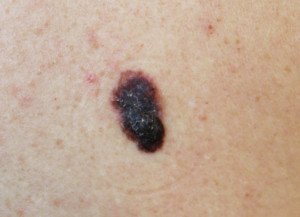
Unfortunately you can get a lot of melanomas at the same time, says Dr. Jennifer Gordon, who is board certified by the American Board of Dermatology.
“Sadly there is no limit,” affirms Dr. Gordon. “Once you have had a melanoma, you are at a higher risk of having another.”
It’s been said that melanoma is rarely a singular event. But that typically pertains to the phenomenon of developing another tumor (or one being discovered) a few years or more after the first one was diagnosed.
But what about primary melanomas at the same time?
I once knew a man — the fitness director at a health club — who announced to us one day that he’d been diagnosed with melanoma.
He showed me three spots: two on his arm and one on his face. So he had at least three going on at the same time.
I do not know if they were individual primaries or if, for instance, the one on his face metastasized to the two on his arm.
Multiple melanomas occurring at the same time is not the same as several melanomas being discovered at the same time.
Certainly, if a tumor is discovered during an examination, a rigorous inspection of the patient’s entire body will ensue, where another malignant spot could be discovered…and another.
But that doesn’t mean that the development of these lesions doesn’t have some time in between them; it’s just that they were found and diagnosed at the same time.
It’s not possible to tell if, for instance, there’s only a few weeks vs. 18 months between the development into existence of the melanoma on a person’s arm and the one on his back; or how much time in development there is between the three on his back.
“This is why dermatologists often like to see patients much more often after a melanoma diagnosis,” says Dr. Gordon, who’s with Westlake Dermatology located in Austin, TX.
“Multiple melanomas at the same time often need to be genetically studied to determine if they are separate primary lesions or related (and thus considered metastatic).”
The image below shows many melanomas at the same time — but they are metastatic — having originated from a primary spot.

canceradvice.co.uk/melanoma/treatment/
A primary tumor is one that arises from the pigmented cells in a mole or develops in the absence of a mole.
A secondary tumor is one that develops elsewhere as a result of cancerous cells having migrated from the primary: a metastasis.
The metastasis or spread could occur at a distant site from the primary, such as on the leg, when the primary is on the chest or neck.
Or, the secondary could occur close to the primary, but in either case, it’s not possible to determine what the time passage is between when the primary first came into existence and when the secondary developed.
It’s not common—in fact it’s rare—that a person could be discovered to have dozens of melanomas at the same time.
There are exceptionally rare cases in which a patient was found to have hundreds of melanomas at the same time.

Dr. Gordon’s interests include medical dermatology, particularly the treatment and prevention of melanoma and other skin cancers in athletes. For 2016, 2017 and 2018 Texas Monthly Magazine selected her as one of the Texas Super Doctors Rising Stars.
 Lorra Garrick has been covering medical, fitness and cybersecurity topics for many years, having written thousands of articles for print magazines and websites, including as a ghostwriter. She’s also a former ACE-certified personal trainer.
Lorra Garrick has been covering medical, fitness and cybersecurity topics for many years, having written thousands of articles for print magazines and websites, including as a ghostwriter. She’s also a former ACE-certified personal trainer.
.











